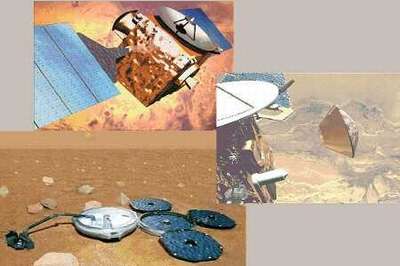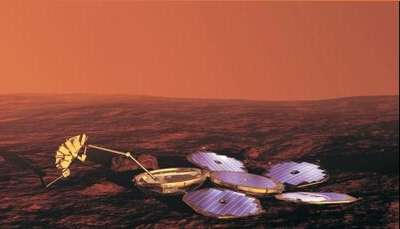Mon, Jun 02, 2003
First Ever European Visit To Red Planet
The wind stirs the dust around the former Soviet Cosmodrome at
Baikonur, in Kazakhstan. On the launch pad, a Russian-built Soyuz
rocket, tipped by a probe called "Beagle II." If all goes according
to plan, by December, the Beagle will have landed on the Martian
surface and begun looking for signs of primitive life on the Red
Planet.

An Interplanetary Mission At Bargain-Basement Prices
The European Mars mission is a study in economic space flight.
The Beagle II cost about $73 million to develop and build.
Management of the project has been largely turned over to private
industry and academia. Instead of launching the probe from the
European Space Agency's facility in South America aboard an Ariane
rocket, mission leaders decided to go to Baikonur and use the
less-expensive, more reliable Soyuz rocket. The launch will be
number 1,677 for the Soyuz program.
Total price tag for the European mission: approximately $300
million.

Red Planet - Cursed Planet?
"Mars is bad luck for space and a real difficulty for us," ESA's
science director David Southwood told Reuters. "If we were sailors,
I think we would be very superstitious about going to Mars."
Indeed, 20 of the past 30 missions to the Red Planet have ended in
something less than success. But Southwood told Reuters that
superstition won't impede the Mars Express project from putting
Beagle II on the surface. "Maybe there was life on Mars once in the
past? We are going to seek evidence of past life ... or indeed,
even micro-organisms that are alive now," Southwood said.

The European probe won't be alone in its trek to the Red Planet,
as Mars and Earth come closer than they've been for the past 66,000
years. There are two NASA orbiters circling the fourth planet and
two more NASA landers are slated for launch later this month. The
American landers contain rovers that are bigger and more
sophisticated than the UK-developed Beagle II. But only Beagle has
that onboard chemical laboratory specifically designed to look for
prehistoric signs of life.
More News
Its Offerings Are Lighter, Cleaner, and Now Pushing Past 1,000nm on SAF Jet Fuel DeltaHawk’s diesel-powered aircraft lineup has seen incredible upgrades over the last few yea>[...]
The Airplane Experienced A Total Loss Of Engine Power On December 3, 2025, about 1600 central standard time, a Mooney Aircraft Corp. M20K, N57229, was substantially damaged when it>[...]
Make Sure You NEVER Miss A New Story From Aero-News Network Do you ever feel like you never see posts from a certain person or page on Facebook or Instagram? Here’s how you c>[...]
Aero Linx: European Society of Aerospace Medicine (ESAM) As a pan-European, independent forum, it works to promote the safety and health of all persons involved in aviation and spa>[...]
“We are excited to see Wisk achieve this milestone, and I’m so proud of the team that made it possible. The team at Wisk has built advanced technologies across flight c>[...]
 Aero-TV: DeltaHawks Diesel Power Steps Into the Spotlight
Aero-TV: DeltaHawks Diesel Power Steps Into the Spotlight NTSB Prelim: Mooney Aircraft Corp. M20K
NTSB Prelim: Mooney Aircraft Corp. M20K ANN FAQ: Turn On Post Notifications
ANN FAQ: Turn On Post Notifications ANN's Daily Aero-Linx (12.20.25)
ANN's Daily Aero-Linx (12.20.25) Aero-News: Quote of the Day (12.20.25)
Aero-News: Quote of the Day (12.20.25)





